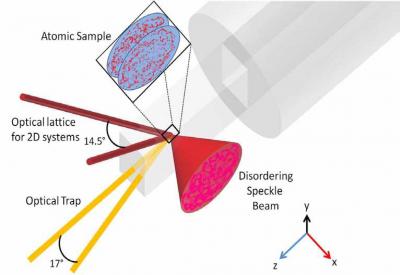Researchers at the Joint Quantum Institute (JQI) have conducted an experiment to study the relationship between imperfections in some materials and quantum coherence at low temperatures. The findings of the study will help in developing improved quantum devices like the superconducting magnets.
 Optical Lattice of Atoms (Credit: Matthew Beeler)
Optical Lattice of Atoms (Credit: Matthew Beeler)
Imperfections or deviations in materials are mostly in the form of disarray amongst atoms. These imperfections on a small scale are advantageous as they improve desirable properties of materials. An example of this is copper wire whose conductivity increases with introduction of impurities. Scientists have been trying to understand the phenomenon of coherence in condensed matter by simulating the behavior of electrons through solids with thin, cold atomic vapors. The JQI experiments are along the lines of these previous attempts.
In the JQI experiment, rubidium atoms at near zero temperature were held together by an array of laser beams or optical lattice. The atoms were all in a single quantum state referred to as a Bose Einstein condensate (BEC). This condition is vital to replicate electrons flowing through solid superconductors. The JQI atoms are kept a micron apart as opposed to the fraction of nanometer spacing between atoms in solids. The disorder in the two-dimensional disk is speckle caused by haphazard scattering of laser beam when it strikes a rough surface. Similar to superconductors, the rubidium atoms continued their coordinated movement in the BEC quantum wave on the strength of supplied speckle disorder. But once the speckle becomes too large, the quantum coherence disappears. Numerically measuring this transition into non-coherence was the aim of the JQI experiment. To detect coherence, the team turned off the laser beams. Subsequently, the two disks of atoms collided. They found that atoms in coherent condition produced a clear interference pattern in the form of dark and light stripes on collision. Loss of coherence washed away the interference pattern.